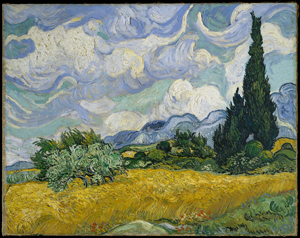12.26.23 — Is It Modernism Yet?
To continue my year-end review from last time, blockbusters always come with hype and hokum, and why not? Shows like these are costly to put on, while bringing in big money, and “van Gogh’s Cypresses” is no exception.
Does it really matter that some pictures include a certain tree? Maybe not, but the Met looked freshly at not just Starry Night, but the fatal last years of Vincent van Gogh. It also brought home his close connection to his brother,  Theo, a dealer and his greatest supporter. Never mind that it came with an upbeat ending that no amount of great art can warrant.
Theo, a dealer and his greatest supporter. Never mind that it came with an upbeat ending that no amount of great art can warrant.
And then in no time the lines were back for “Manet / Degas.” Can even a blockbuster sort out two creative minds and big egos? Maybe not, but it could still begin with Edouard Manet and Edgar Degas on their meeting in the Louvre and end with their envisioning Paris and politics through the lens of old masters and present-day ideas. It should have anyone continuing on to the Met’s galleries for European art, open again after the “Skylight Project.” It, too, comes with hokum, between loaded themes and forced interruptions for contemporary art. Still, this is the heart of a great museum.
Down in the Lehman wing, the Met jumps ahead to Fauvism and “Vertigo of Color.” It, too, has a dubious narrative, of just two artists and one summer—and it, too, is an all-male preserve. Still, if you never understood what brought Henri Matisse and André Derain together and how they differ, here you can. The show also returns to the role of painting out of doors in the creation of modern art. So, for that matter, did “Into the Woods,” French landscapes at the Morgan Library. Whose woods these are I only thought I knew.
Same goes for whose Modernism. Can Manet, who stood just outside Impressionism, and Degas, often seen as Post-Impressionist, point ahead to modern art and Pablo Picasso? As it happens, this was an anniversary year for Picasso, and museums all over the world competed to give him a really big show. So did at least one posh gallery, Gagosian, with documentation to match. The celebration included some lemons, like a comedian’s put-down of Picasso in Brooklyn, and revealing sidelights, like his early days in France at the Guggenheim. Yet they should already have one looking beyond the blockbusters.
My own favorite sidelights told of how Cubism never made it to a townhouse in Brooklyn—and how a stay in Fontainebleau led to two of Picasso’s most famous paintings. Like Matisse’s Red Studio last year, they suggest the importance of place—and a decent place to work. They also continue an exploration of when to declare art modern and what it took to get there. So did a show at the Morgan of Blaise Cendrars, a French poet, and his collaborations with modern artists. Oh, and how did America enter the picture, and when did Modernism become abstraction? MoMA looked for answers to both to Georgia O’Keeffe.
Is a return to so popular a painter just more of the same? Up to a point, although it stuck to her drawings. Besides flowers, it also held patterning for its own sake and views from an airplane window onto the earth, with its rivers, roads, and fissures. Like a true American, O’Keeffe took to the highway, only from above. I could not shake it out of my mind when I caught Chris Gallagher this fall at McKenzie on the Lower East Side. He does not need to look past the window itself for abstract art—and I continue next time with how to look beyond.
Read more, now in a feature-length article on this site.